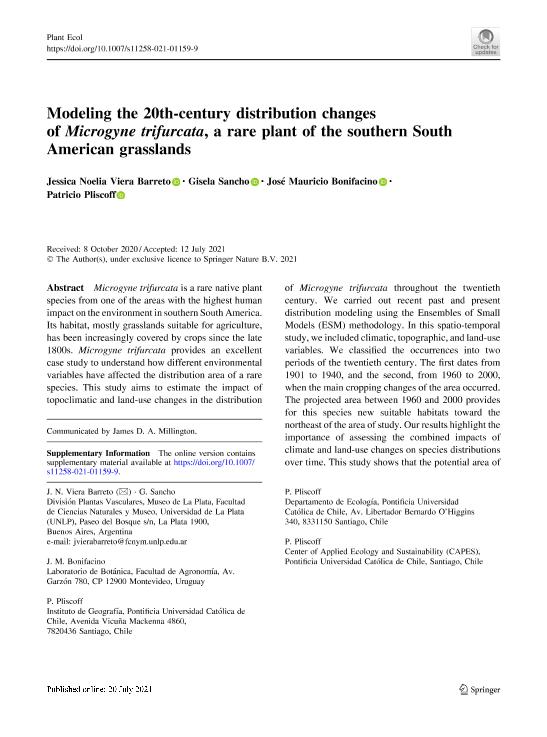Mostrar el registro sencillo del ítem
dc.contributor.author
Viera Barreto, Jessica Noelia

dc.contributor.author
Sancho, Gisela

dc.contributor.author
Bonifacino, José Mauricio
dc.contributor.author
Pliscoff, Patricio
dc.date.available
2022-03-08T13:15:23Z
dc.date.issued
2021-07
dc.identifier.citation
Viera Barreto, Jessica Noelia; Sancho, Gisela; Bonifacino, José Mauricio; Pliscoff, Patricio; Modeling the 20th-century distribution changes of Microgyne trifurcata, a rare plant of the southern South American grasslands; Springer; Plant Ecology; 222; 9; 7-2021; 1033-1049
dc.identifier.issn
1385-0237
dc.identifier.uri
http://hdl.handle.net/11336/153033
dc.description.abstract
Microgyne trifurcata is a rare native plant species from one of the areas with the highest humanimpact on the environment in southern South America. Its habitat, mostly grasslands suitable for agriculture, has been increasingly covered by crops since the late 1800s. Microgyne trifurcata provides an excellent case study to understand how different environmental variables have affected the distribution area of a rare species. This study aims to estimate the impact of topoclimatic and land-use changes in the distribution of Microgyne trifurcata throughout the twentieth century. We carried out recent past and present distribution modeling using the Ensembles of Small Models (ESM) methodology. In this spatio-temporal study, we included climatic, topographic, and land-usevariables. We classified the occurrences into two periods of the twentieth century. The first dates from 1901 to 1940, and the second, from 1960 to 2000, when the main cropping changes of the area occurred. The projected area between 1960 and 2000 provides for this species new suitable habitats toward the northeast of the area of study. Our results highlight the importance of assessing the combined impacts of climate and land-use changes on species distributionsover time. This study shows that the potential area of Microgyne trifurcata decreased and underwent fragmentation throughout the twentieth century when these variables combined are used to model its distribution. Our outcomes prompt future studies on the vulnerability of Microgyne trifurcata to outline conservation strategies.
dc.format
application/pdf
dc.language.iso
eng
dc.publisher
Springer

dc.rights
info:eu-repo/semantics/openAccess
dc.rights.uri
https://creativecommons.org/licenses/by-nc-sa/2.5/ar/
dc.subject
ensemble modeling
dc.subject
land-use changes
dc.subject
grasslands
dc.subject
Argentina
dc.subject.classification
Conservación de la Biodiversidad

dc.subject.classification
Ciencias Biológicas

dc.subject.classification
CIENCIAS NATURALES Y EXACTAS

dc.title
Modeling the 20th-century distribution changes of Microgyne trifurcata, a rare plant of the southern South American grasslands
dc.type
info:eu-repo/semantics/article
dc.type
info:ar-repo/semantics/artículo
dc.type
info:eu-repo/semantics/publishedVersion
dc.date.updated
2022-03-02T15:46:33Z
dc.journal.volume
222
dc.journal.number
9
dc.journal.pagination
1033-1049
dc.journal.pais
Alemania

dc.journal.ciudad
Berlin
dc.description.fil
Fil: Viera Barreto, Jessica Noelia. Universidad Nacional de La Plata. Facultad de Ciencias Naturales y Museo. División de Plantas Vasculares; Argentina. Consejo Nacional de Investigaciones Científicas y Técnicas. Centro Científico Tecnológico Conicet - La Plata; Argentina
dc.description.fil
Fil: Sancho, Gisela. Consejo Nacional de Investigaciones Científicas y Técnicas. Centro Científico Tecnológico Conicet - La Plata; Argentina. Universidad Nacional de La Plata. Facultad de Ciencias Naturales y Museo. División de Plantas Vasculares; Argentina
dc.description.fil
Fil: Bonifacino, José Mauricio. Universidad de Montevideo; Uruguay
dc.description.fil
Fil: Pliscoff, Patricio. Pontificia Universidad Católica de Chile; Chile
dc.journal.title
Plant Ecology

dc.relation.alternativeid
info:eu-repo/semantics/altIdentifier/url/https://link.springer.com/article/10.1007/s11258-021-01159-9
dc.relation.alternativeid
info:eu-repo/semantics/altIdentifier/doi/http://dx.doi.org/10.1007/s11258-021-01159-9
Archivos asociados
